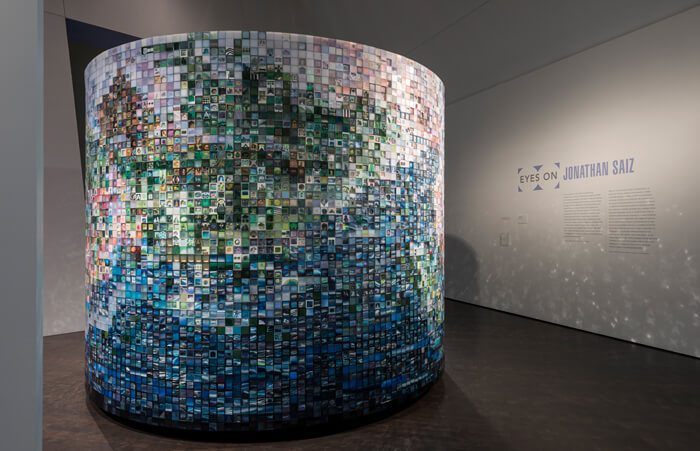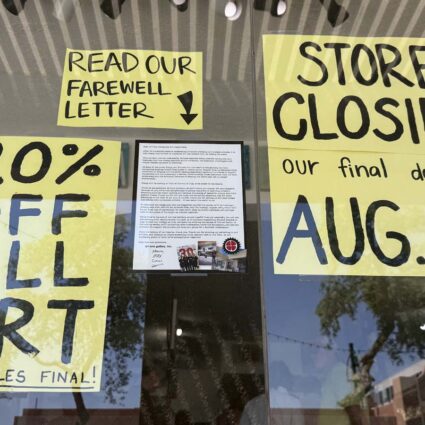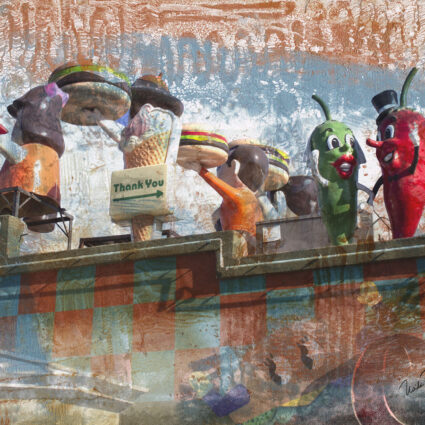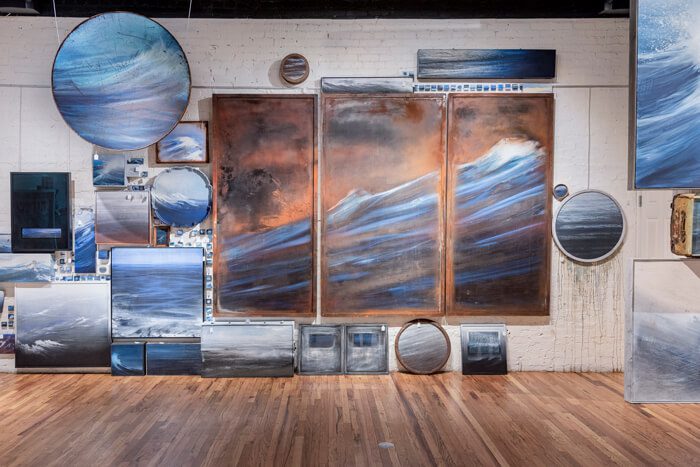
K Contemporary, Denver, mixed media. Courtesy K Contemporary.
#WhatisUtopia
May 12 – November 17, 2019
Denver Art Museum, Denver
Jonathan Saiz: Colorado Coastal
June 8 – July 6, 2019
K Contemporary, Denver
Denver artist Jonathan Saiz believes in the value of shock and surprise, as evidenced in two overlapping solo exhibitions. One is #WhatisUtopia, in which ten thousand miniature squares come together in a mosaic-like column given its own space at the Denver Art Museum (DAM). Part of the DAM’s “Eyes On . . .” series, the column has attracted crowds who spend considerable time moving in close and perusing the matchbook-size tiles, some expressionistically painted and some filled with found objects such as gemstones or tiny clay and paper sculptures. Each square is unique, an artwork unto itself. And the surprise: all the squares will be given away at the end of the show.
The second exhibition, at K Contemporary, is darker in tone, shocking you to attention with foreboding images. The title, Colorado Coastal, is a wry oxymoron but ultimately a portentous phrase about rising sea levels wrought by climate change. Here, Saiz mounts enormous vinyl black letters across the length of an entire fifty-foot-long wall, echoing an ominous Biblical phrase in the all-caps text, “The writing on the wall.” On the opposite and adjoining walls are oil and mixed-media paintings—seascapes primarily—of various sizes and shapes. Saiz often lets them loosely overlap each other, or form stacks, or lean against the wall. Depicting troubled seas and skies with thick brushwork, the paintings are individually interesting, yet you can stand back and recognize how they form a cresting wave—an immersive effect. Viewers may be shocked to see that the paintings carry titles like Aurora, Thornton, Denver Museum of Nature and Science, and City Park. Then there’s Coors Field, a large triptych in which Saiz has mixed cinnamon with oil paint and varnish to darken the skies. In Saiz’s vision, the landmarks and sites where climate change has proceeded undeterred have turned everything, well, coastal.
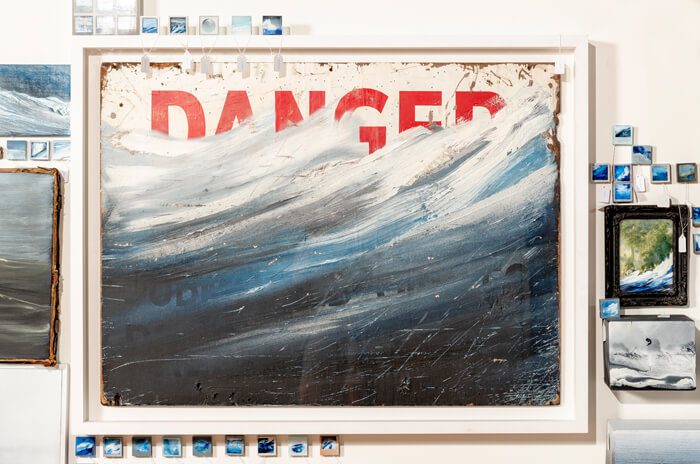
K Contemporary, Denver, mixed media. Courtesy K Contemporary.
The exhibition nearly comes on too strong with its warnings, yet you can’t help but be swept along by the overall effect and its reflection of Saiz’s concern. Saiz has said in interviews that he’ll scream his warnings if he has to, so vivid are his nightmares about “mile-high tsunamis.” Among the standout works is Civic Center Park, which positions the word “danger” in red lettering obscured by waves. Several works are unusually mounted in second-hand frames or scrap wood, and a handful are inserted into empty, old suitcases, stirring thoughts of displacement and trauma. Paintings that have been spray-painted onto weathered tarps suggest a future of harshness and want.
Saiz intentionally wanted to bring the number of works in the show to one thousand to make an expansive statement. To that end, he’s surrounded almost every larger painting with rows of two-by-two-inch plastic boxes encasing mini seascapes that again evoke oceans with thick strokes of blue, gray, white, and black paint. Despite their outward simplicity, they bring a micro point of view to the macro topic of rising sea levels.
A simultaneous objective of Saiz’s exhibitions is knocking down perceptions of art as a hallowed commodity for the elite. That’s why many of the small boxes on view at K Contemporary are free. It’s Saiz’s counterpoint to the art world’s current state of hyper-commodification. At the DAM exhibition, not only are the two-by-two-inch pieces of the mosaic going to be given away when the column is disassembled, but Saiz also has built in a high community engagement quotient. Visitors are invited to join a dialogue, through Instagram, sharing their visions for a modern utopia. Responses are projected onto a screen near the column.
It’s fortunate that the two exhibitions overlapped for a time, because while Colorado Coastal evokes despair in the face of climate change denial and inaction, #WhatisUtopia stands like a pillar of hope—as long as idealistic artists like Saiz keep rocking the proverbial boat.
